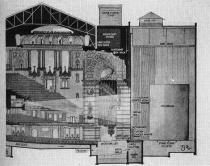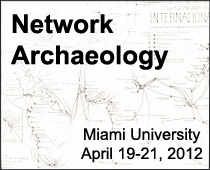Posts Tagged: media archaeology

Digging Through Archives and Dirt: Entangling Media Archaeology, Archaeology Proper, and Architectural History
Presentation by Shannon Mattern (The New School). In the introduction to their new media archaeology anthology, Erkki Huhtamo and Jussi Parikka propose that “[m]edia archaeology should not be confused with archaeology as a discipline. When media archaeologists claim that they

Digging Through Archives and Dirt: Entangling Media Archaeology, Archaeology Proper, and Architectural History
Presentation by Shannon Mattern (The New School). In the introduction to their new media archaeology anthology, Erkki Huhtamo and Jussi Parikka propose that “[m]edia archaeology should not be confused with archaeology as a discipline. When media archaeologists claim that they

Half-Inch Revolution: Guerrilla Television’s Tape Networks
Presentation by Kris Paulsen (The Ohio State University). The Rays, a 1970 videotape by the Raindance Corporation, shows something curious: As the three collaborators record each other, rhythmic waves flow across the screen. In each wave there are bits of

Half-Inch Revolution: Guerrilla Television’s Tape Networks
Presentation by Kris Paulsen (The Ohio State University). The Rays, a 1970 videotape by the Raindance Corporation, shows something curious: As the three collaborators record each other, rhythmic waves flow across the screen. In each wave there are bits of

Divining the Network With the Forked Twig: An Archaeological Approach to Locative Media
Presentation by Alex M. Ingersoll (University of North Carolina, Chapel Hill). Locative media and augmented reality applications are part of an increasingly popular group of digital technologies that determine a user’s or object’s physical, geographical position and then provide an

Divining the Network With the Forked Twig: An Archaeological Approach to Locative Media
Presentation by Alex M. Ingersoll (University of North Carolina, Chapel Hill). Locative media and augmented reality applications are part of an increasingly popular group of digital technologies that determine a user’s or object’s physical, geographical position and then provide an
Network F(or)ever
Presentation by Briankle G. Chang (University of Massachusetts, Amherst). If we could speak of network, as I am intending to do now, it is because we are already in the network we are speaking about. Taking this as its starting
Network F(or)ever
Presentation by Briankle G. Chang (University of Massachusetts, Amherst). If we could speak of network, as I am intending to do now, it is because we are already in the network we are speaking about. Taking this as its starting
TRANS.MISSION [A.DIALOUGE]: Locating Narrative Resonance in Transatlantic Communications Networks
Performance by J. R. Carpenter (University College Falmouth, Cornwall). TRANS.MISSION [A.DIALOUGE] is a computer-generated narrative spanning generations of transatlantic migrations, propagating across long-distance communications networks. The JavaScript source code generates another sort of script, an asynchronous dialogue to be read
TRANS.MISSION [A.DIALOUGE]: Locating Narrative Resonance in Transatlantic Communications Networks
Performance by J. R. Carpenter (University College Falmouth, Cornwall). TRANS.MISSION [A.DIALOUGE] is a computer-generated narrative spanning generations of transatlantic migrations, propagating across long-distance communications networks. The JavaScript source code generates another sort of script, an asynchronous dialogue to be read

Last In, First Out: Media Archaeology of/as the Stack
Presentation by Rory Solomon (The New School). Essential to any analysis of networked media is an understanding of the “stack.” This oft cited diagrammatic illustrates how protocol is operationalized within networked systems. Protocol, as Alex Galloway has written, is the

Last In, First Out: Media Archaeology of/as the Stack
Presentation by Rory Solomon (The New School). Essential to any analysis of networked media is an understanding of the “stack.” This oft cited diagrammatic illustrates how protocol is operationalized within networked systems. Protocol, as Alex Galloway has written, is the

A Media Archaeology of the List: Knowledge and Materiality in History
Presentation by Liam Young (University of Western Ontario). This paper examines ‘the list’ as a communicative device and material form. It seeks to map out functional connections between the list and the network as a means by which to more

A Media Archaeology of the List: Knowledge and Materiality in History
Presentation by Liam Young (University of Western Ontario). This paper examines ‘the list’ as a communicative device and material form. It seeks to map out functional connections between the list and the network as a means by which to more


